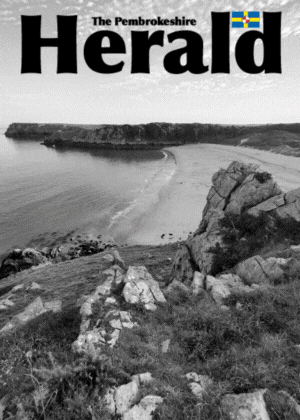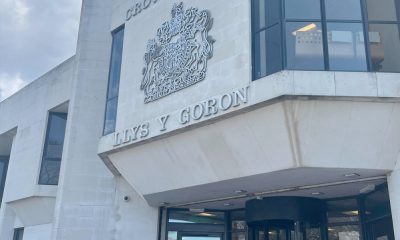Community
Treasure discovered from Bronze Age and Roman era in South Wales and Powys

FIVE treasure finds, including three hoards and two grave groups from the Bronze Age and Roman era, were declared as treasure on Tuesday 11th July 2023 by Patricia Morgan, the Area Coroner for South Wales Central.
A burial group from the Bronze Age consisting of a small gold penannular ring and fragments of a burnt wooden comb (Treasure Case 17.13) was unearthed by Rubicon Heritage Services (Red River Archaeology Group) during archaeological excavations in the St Nicholas and Bonvilston Community on 28th July 2017. The discovery was made as part of the archaeological work preceding the A4426 Five Mile Lane improvements road scheme, funded by the Welsh Government and executed by Cyngor Bro Morgannwg – Vale of Glamorgan Council. The two artifacts were found accompanying a human cremation burial in a small burial pit. The burial and the artifacts were meticulously recorded before being removed. A license was obtained from the Ministry of Justice, allowing the removal of the ancient human remains.
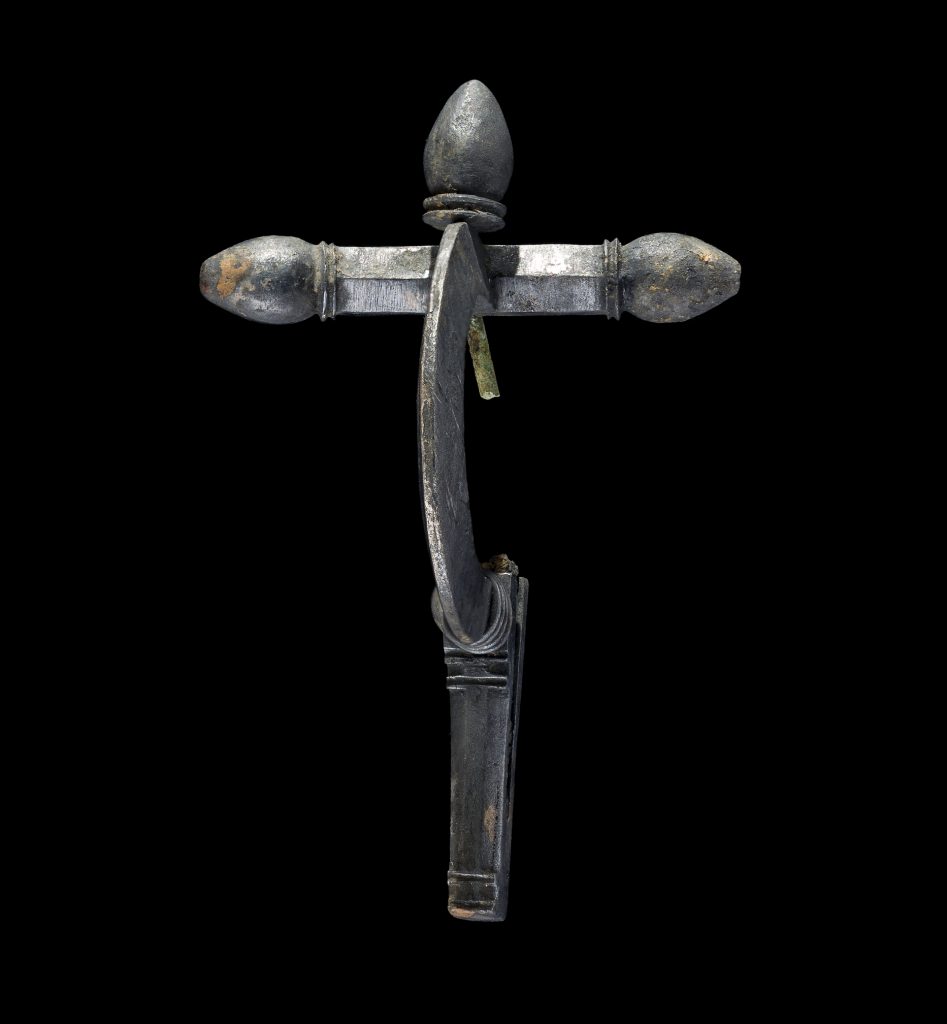
The gold penannular ring, measuring just 1.1cm in diameter, is a beautifully crafted piece decorated with a finely worked chevron or herringbone pattern. It represents an early example of a hair-ring, believed to have been used for hair decoration. The fragmentary wooden comb, with eight narrow and parallel teeth, is in a fragile state. It is an incredibly rare organic artifact that survived due to its charred state. These two objects, dating back to the Middle Bronze Age (1300-1150 BC), were carefully chosen as grave goods to accompany the deceased in the afterlife.
Adam Gwilt, the Principal Curator for Prehistory at Amgueddfa Cymru – Museum Wales, commented, “This cremation burial, with its accompanying gold ring and wooden comb, provides us with a glimpse into life and death during the Bronze Age. The gold ring is an early, well-crafted, and small example of its kind, offering new insights into the development of hair-rings as early forms of jewelry in Britain and Ireland. This grave is just one example of the wealth of prehistoric burial evidence being discovered across the Vale of Glamorgan, highlighting the richness, diversity, and significance of this archaeology and enhancing our understanding of the past.”
Amgueddfa Cymru – Museum Wales is interested in acquiring this discovery after an independent valuation by the Treasure Valuation Committee. The artifacts will become part of the broader collection and archive from this archaeological excavation, which is destined for the national collection.
David Gilbert, the Project Manager for Rubicon Heritage Services (Red River Archaeology Group), stated, “The gold ring is undoubtedly the most eye-catching object accompanying the cremation. However, the most important artifact is what may initially seem more mundane: the wooden comb. It is an unparalleled find in Wales, if not the UK. Together, these objects add a human element to our work, highlighting their significance to the person buried with them. They demonstrate the attention to detail and pride in appearance often missing from depictions of prehistoric people on television or in films. This discovery emphasizes the significant contribution made by commercial archaeology to advancing our detailed knowledge of the history of Wales.”
Another Roman burial was excavated by Rubicon Heritage Services (Red River Archaeology Group) in April 2017, as part of the archaeological work preceding the A4426 Five Mile Lane improvements road scheme, funded by the Welsh Government and executed by Cyngor Bro Morgannwg – Vale of Glamorgan Council. The burial included a silver crossbow brooch, the remains of an iron sword, and hobnails from a pair of shoes. This find underscores the valuable contribution of commercial archaeology in expanding our understanding of Wales’ history. The silver crossbow brooch, over 300 years old, falls under the remit of the Treasure Act (Treasure Case 17.06).
Crossbow brooches, a common type of Roman bow brooch, are predominantly made of copper alloy, although examples made of silver or gold exist. The sword discovered belongs to the longer type used by the Roman army in the third and fourth centuries AD, corresponding with the dating of the brooch.
Evan Chapman, the Senior Curator for Archaeology at Amgueddfa Cymru – Museum Wales, stated, “To the best of my knowledge, this is the first example of a Roman silver crossbow brooch found in Wales. Crossbow brooches appear to be associated with the late Roman army and civil service, possibly originally serving as badges of office. However, it has been suggested that elements of military dress, including crossbow brooches, were embraced by the wider elite. The presence of the sword supports the military connection in this case. Regardless of direct affiliation with the Roman army, the silver brooch indicates an individual of elite status.”
Amgueddfa Cymru – Museum Wales is interested in acquiring these objects following an independent valuation by the Treasure Valuation Committee. The artifacts will remain together with the rest of the finds from the excavations, which are already destined for the national collection.
Rachel Morgan, the Project Archaeologist for Rubicon Heritage Services (Red River Archaeology Group), remarked, “The burial of a young man in military attire was an unexpected discovery within a Roman field system. The silver crossbow brooch found with the individual signifies his important status within the military or wider society. His death occurred sometime between the mid-3rd to late 4th century, during which the brooch had become a symbol of imperial administrators. Therefore, he was unlikely to have been an ordinary soldier and evidently possessed significant wealth. Isotope analysis also revealed that he was not from the local area but likely grew up further east, possibly from the Welsh borders or beyond. The question arises: what was this wealthy man doing on a farm in south Wales when he died?”
A Bronze Age hoard of tools and weapons (Treasure Case 20.22) was discovered by Richard Griffiths on 17th December 2020 while using a metal detector in a boggy field in the Coychurch Higher Community, Bridgend. The hoard consists of seven bronze artifacts, including four fragmented socketed axes, a spearhead, a palstave, and a casting jet. Dating back to the Late Bronze Age (1000-800 BC), the hoard was originally buried in a small and isolated pit, likely as a religious offering to the gods. Relatively few hoards from this period are known in the uplands of south Wales, making this find crucial in enriching our knowledge of the people who lived in the area around 3,000 years ago.
An investigation of the findspot was carried out in August 2022 by a team from Amgueddfa Cymru and the Portable Antiquities Scheme Wales (PAS Cymru), with assistance from the finder.
Richard Griffiths, the metal detectorist who discovered the hoard, expressed his excitement, saying, “I was thrilled to find this Bronze Age hoard, and it’s truly special to know that my find is now a part of our shared history. To think that I was the first person to hold these objects since the last person who used them, thousands of years ago, is a remarkable feeling. I enjoyed being involved with the museum archaeologists during their geophysics work and the small dig. It was fascinating to see how they carefully dug and recorded everything. The unexpected discovery of the buried spearhead added another interesting twist to the story!”
Chris Griffiths, a researcher at Amgueddfa Cymru, who led the investigation of the findspot, commented, “The opportunity to study the location of this hoard was invaluable, and we are extremely grateful for the cooperation of the landowner and Richard throughout this process. The discovery of a bronze spearhead during the investigation was the ‘icing on the cake,’ providing us with fascinating insights into how Bronze Age people interacted with this upland landscape.”
Amgueddfa Cymru – Museum Wales is interested in acquiring this find after an independent valuation by the Treasure Valuation Committee.
David Howell, the Engagement Officer for the Portable Antiquities Scheme in Wales (PAS Cymru), stated, “For 25 years, the Portable Antiquities Scheme in Wales has been working to preserve knowledge and information about Welsh archaeology. During this time, PAS Cymru has recorded over 90,000 artifacts, establishing connections with the metal-detecting community and finders in general, to ensure that information about Welsh archaeology and history is recorded and shared with the nation.”
A Bronze Age hoard (Treasure Case 21.15) was discovered by Peter Anning while metal-detecting in a pasture field in the Pontprennau Community, Cardiff, on 30th October 2020. The hoard was initially reported to Mark Lodwick through the Portable Antiquities Scheme in Wales (PAS Cymru). It includes four fragments of a blade from a single leaf-shaped sword and two casting jets, which were generated during the casting of bronze artifacts in clay molds. The sword fragments belong to a type known as an Ewart Park sword, and one of the casting jets was created during the casting of a South Wales type socketed axe. These findings indicate that the hoard dates back to the Late Bronze Age, around 1000-800 BC. The artifacts were deliberately buried together in a small pit, most likely as a religious offering.
The Museum of Cardiff is interested in acquiring this hoard for its collection, pending an independent valuation by the Treasure Valuation Committee. The sword would be the museum’s first of its kind and a valuable addition to their Bronze Age archaeology collection, which already includes a socketed axe. The casting jets will contribute to the narrative surrounding the production of such axes in Bronze Age Cardiff. By acquiring this hoard, the museum will be able to expand their storytelling of this era and their collection from the Pontprennau area of Cardiff.
Chris Griffiths, a doctoral student at the University of Reading and Amgueddfa Cymru – Museum Wales, commented, “It is rare to find multiple joining pieces of swords from south Wales, making this hoard from Pontprennau Community, containing four blade fragments from a single sword, a significant new discovery. Prior to burial, the sword appears to have been deliberately broken into pieces, with some missing fragments possibly being recycled to create other objects. The way in which this sword was broken, combined with the presence of two casting jets, suggests the involvement of a local bronzesmith in creating this hoard, allowing us to imagine the lives of people who lived in this part of Cardiff around 3,000 years ago.”
A small hoard of Roman coins (Treasure Case 21.18) was found by Shawn Hendry and Chris Perkins in May 2021 while using metal detectors in a pasture field in the Glascwm Community, Powys. The coin group comprises six silver coins, known as denarii, ranging in date from 32 BC to AD 161. The coins feature representations of Mark Antony, as well as the emperors Titus, Hadrian, and Antoninus Pius. The latest coin in the group could have been minted as late as AD 161, indicating that the coins were likely lost together between AD 145 and 165. Most of the coins were in circulation for a long period before they were lost, and the earliest coin, belonging to Mark Antony (32-1 BC), is highly worn. The coins were probably lost as a small purse group or as a small hoard.
The Radnorshire Museum is interested in acquiring this hoard, following an independent valuation by the Treasure Valuation Committee.
Amgueddfa Cymru is a charity and a family of seven national museums and a collections center located across the country. The aim of the organization is to inspire everyone through Wales’ story, at the museums, in communities, and online. Admission is free, thanks to funding from the Welsh Government, and everyone is welcome.
To learn more about Amgueddfa Cymru’s seven museums, follow them on Twitter, Instagram, or Facebook.
Community
Narbelles WI support Food Bank with festive donation

Group marks December meeting with charity collection and Christmas celebrations
NARBELLES WI rounded off the year with a festive December meeting featuring a bring-and-share buffet, party games and a Secret Santa gift exchange.
Members also used the occasion to support families in need across the county, collecting food items and presenting a £120 cheque to Ann Watling from Pembrokeshire Food Bank. The donation represents the proceeds of the group’s bucket collection during Narberth Civic Week 2024.
A spokesperson for the WI said the group was delighted to finish the year “with fun, friendship and a chance to give something back to the community.”
(Photo: Narbelles WI members presenting the cheque to Ann Watling, Pembrokeshire Food Bank.)
Community
Annual charity carol service raises funds for good causes

MID and West Wales Fire and Rescue Service held its annual Charity Carol Service on Wednesday (Dec 10) at Ebeneser Baptist Chapel in Crymych.
The event brought together members of the local community alongside Fire Service staff for an evening of carols, readings and festive refreshments, marking the Christmas season in a warm and inclusive atmosphere.
This year’s service supported two important charities — the Fire Fighters Charity and Cancer Research Wales — with all proceeds going directly towards their ongoing work.
A total of £597 was raised on the night, which will be shared equally between the two charities.
The Service thanked the congregation at Ebeneser Baptist Chapel for hosting the event, as well as everyone who gave their time, support and generosity to make the evening such a success.
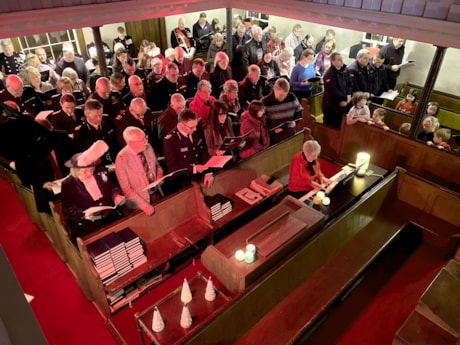
Community
3 Amigos toy bike run under way across Pembrokeshire

Castle Inn fun runners back festive charity event
THE ANNUAL 3 Amigos Christmas toy bike run is under way this afternoon (Saturday), with hundreds of motorcyclists setting off from Pembroke to raise funds for children’s services.
Riders gathered at The Commons car park in Pembroke from around midday before departing shortly after 1:00pm. The festive convoy is travelling along its traditional route, taking in Pembroke Dock and continuing through parts of the county including Neyland, Milford Haven and Haverfordwest.












The event is organised by the 3 Amigos and Dollies Motorcycle Group and has become a much-anticipated Christmas tradition in west Wales, with toys and donations collected for children receiving care within the Hywel Dda University Health Board area.
Also supporting the event are fun runners from the Castle Inn in Pembroke, who have been fundraising in aid of the 3 Amigos. The group are pictured alongside participants from today’s run.
The 3 Amigos have been raising funds for children’s wards and health charities for more than twenty-five years, with their Easter and Christmas events continuing to make a positive difference to young patients and their families.
Organisers have thanked the public for their support and asked road users to be mindful of the large convoy as it passes through towns and villages this afternoon.
Photo caption:
Festive fundraising: Fun runners from the Castle Inn, Pembroke, pictured supporting the 3 Amigos Christmas toy bike run (Pic: Martin Cavaney/Herald)
-

 Crime6 days ago
Crime6 days agoPhillips found guilty of raping baby in “worst case” judge has ever dealt with
-
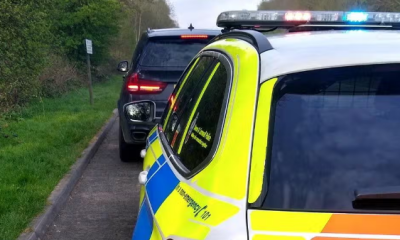
 Crime5 days ago
Crime5 days agoKilgetty scaffolder sentenced after driving with cocaine and in system
-

 Crime5 days ago
Crime5 days agoHousing site director sentenced after failing to provide breath sample following crash
-

 Crime5 days ago
Crime5 days agoMotorist banned for three years after driving with cannabis in system
-

 News16 hours ago
News16 hours agoDyfed-Powys Police launch major investigation after triple fatal crash
-

 Crime1 day ago
Crime1 day agoMan spared jail after baseball bat incident in Milford Haven
-

 Education4 days ago
Education4 days agoTeaching assistant struck off after asking pupil for photos of her body
-

 News7 days ago
News7 days agoJury retires tomorrow in harrowing Baby C rape trial







